warning MAZDA MODEL MAZDASPEED 3 2008 (in English) Owner's Manual
[x] Cancel search | Manufacturer: MAZDA, Model Year: 2008, Model line: MODEL MAZDASPEED 3, Model: MAZDA MODEL MAZDASPEED 3 2008Pages: 394, PDF Size: 7.62 MB
Page 46 of 394
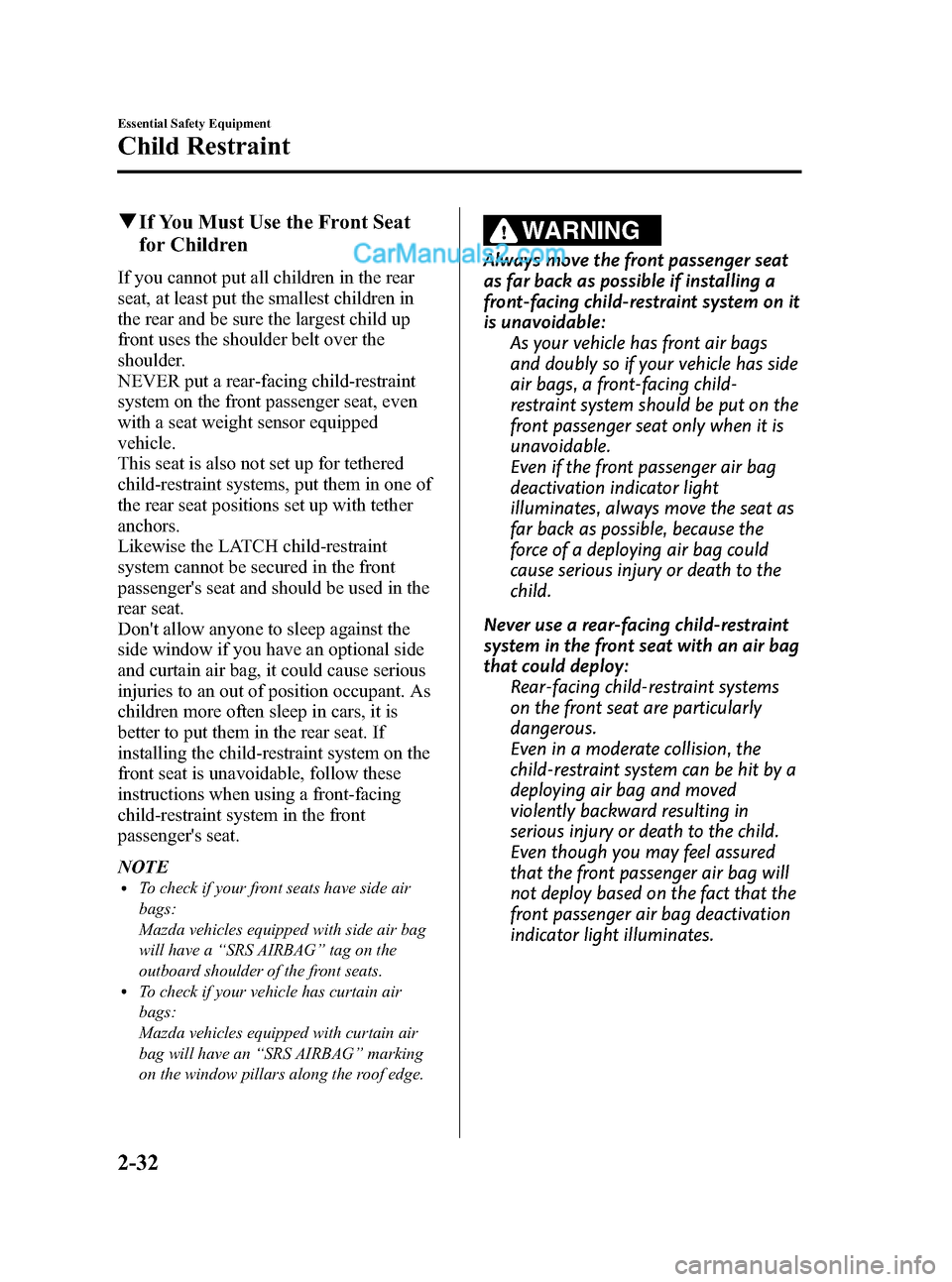
Black plate (46,1)
qIf You Must Use the Front Seat
for Children
If you cannot put all children in the rear
seat, at least put the smallest children in
the rear and be sure the largest child up
front uses the shoulder belt over the
shoulder.
NEVER put a rear-facing child-restraint
system on the front passenger seat, even
with a seat weight sensor equipped
vehicle.
This seat is also not set up for tethered
child-restraint systems, put them in one of
the rear seat positions set up with tether
anchors.
Likewise the LATCH child-restraint
system cannot be secured in the front
passenger's seat and should be used in the
rear seat.
Don't allow anyone to sleep against the
side window if you have an optional side
and curtain air bag, it could cause serious
injuries to an out of position occupant. As
children more often sleep in cars, it is
better to put them in the rear seat. If
installing the child-restraint system on the
front seat is unavoidable, follow these
instructions when using a front-facing
child-restraint system in the front
passenger's seat.
NOTE
lTo check if your front seats have side air
bags:
Mazda vehicles equipped with side air bag
will have a“SRS AIRBAG”tag on the
outboard shoulder of the front seats.
lTo check if your vehicle has curtain air
bags:
Mazda vehicles equipped with curtain air
bag will have an“SRS AIRBAG”marking
on the window pillars along the roof edge.
WARNING
Always move the front passenger seat
as far back as possible if installing a
front-facing child-restraint system on it
is unavoidable:
As your vehicle has front air bags
and doubly so if your vehicle has side
air bags, a front-facing child-
restraint system should be put on the
front passenger seat only when it is
unavoidable.
Even if the front passenger air bag
deactivation indicator light
illuminates, always move the seat as
far back as possible, because the
force of a deploying air bag could
cause serious injury or death to the
child.
Never use a rear-facing child-restraint
system in the front seat with an air bag
that could deploy:
Rear-facing child-restraint systems
on the front seat are particularly
dangerous.
Even in a moderate collision, the
child-restraint system can be hit by a
deploying air bag and moved
violently backward resulting in
serious injury or death to the child.
Even though you may feel assured
that the front passenger air bag will
not deploy based on the fact that the
front passenger air bag deactivation
indicator light illuminates.
2-32
Essential Safety Equipment
Child Restraint
Mazda3_8X41-EA-07F_Edition1 Page46
Wednesday, April 25 2007 1:4 PM
Form No.8X41-EA-07F
Page 48 of 394
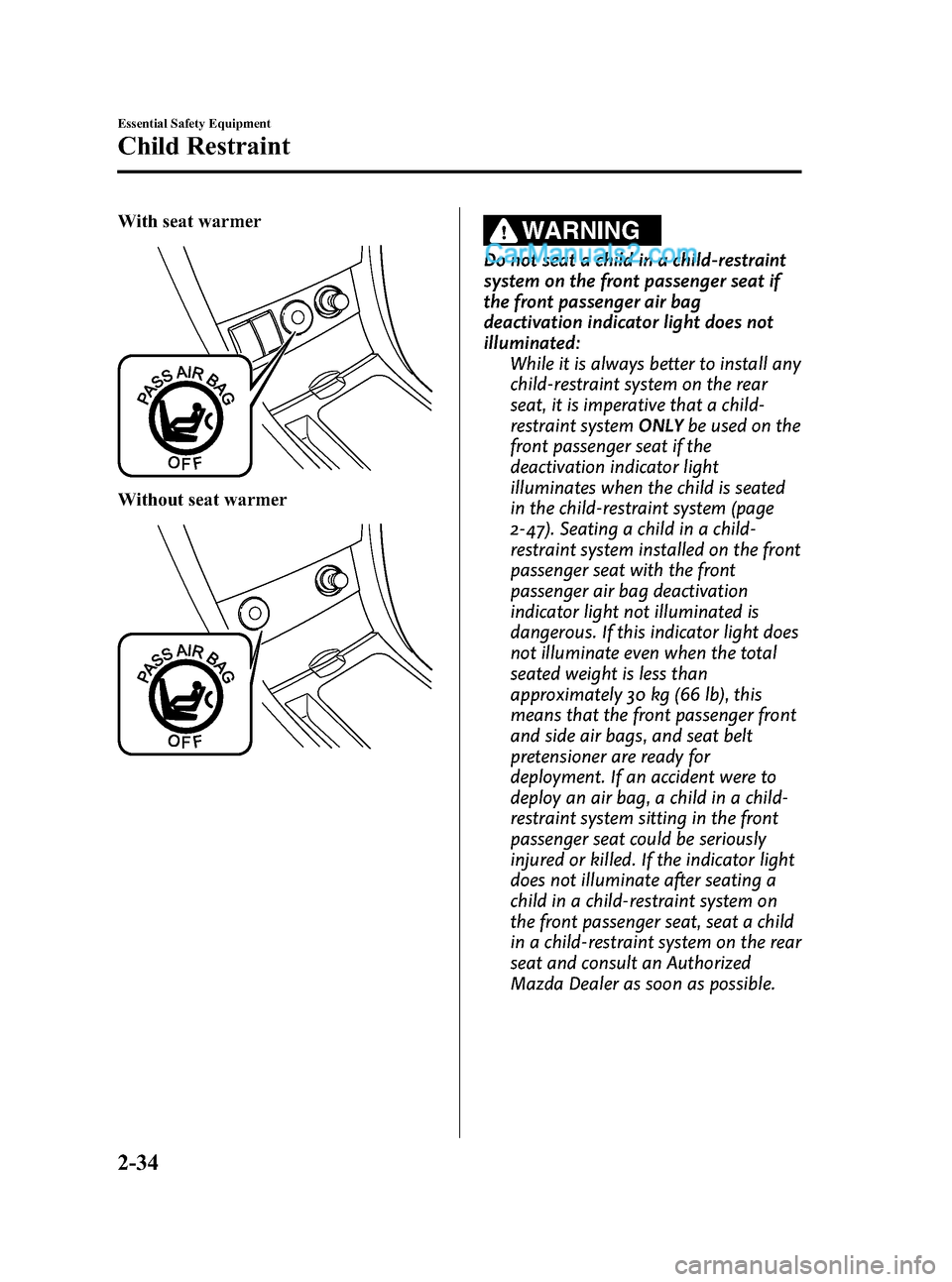
Black plate (48,1)
With seat warmer
Without seat warmer
WARNING
Do not seat a child in a child-restraint
system on the front passenger seat if
the front passenger air bag
deactivation indicator light does not
illuminated:
While it is always better to install any
child-restraint system on the rear
seat, it is imperative that a child-
restraint systemONLYbe used on the
front passenger seat if the
deactivation indicator light
illuminates when the child is seated
in the child-restraint system (page
2-47). Seating a child in a child-
restraint system installed on the front
passenger seat with the front
passenger air bag deactivation
indicator light not illuminated is
dangerous. If this indicator light does
not illuminate even when the total
seated weight is less than
approximately 30 kg (66 lb), this
means that the front passenger front
and side air bags, and seat belt
pretensioner are ready for
deployment. If an accident were to
deploy an air bag, a child in a child-
restraint system sitting in the front
passenger seat could be seriously
injured or killed. If the indicator light
does not illuminate after seating a
child in a child-restraint system on
the front passenger seat, seat a child
in a child-restraint system on the rear
seat and consult an Authorized
Mazda Dealer as soon as possible.
2-34
Essential Safety Equipment
Child Restraint
Mazda3_8X41-EA-07F_Edition1 Page48
Wednesday, April 25 2007 1:4 PM
Form No.8X41-EA-07F
Page 49 of 394
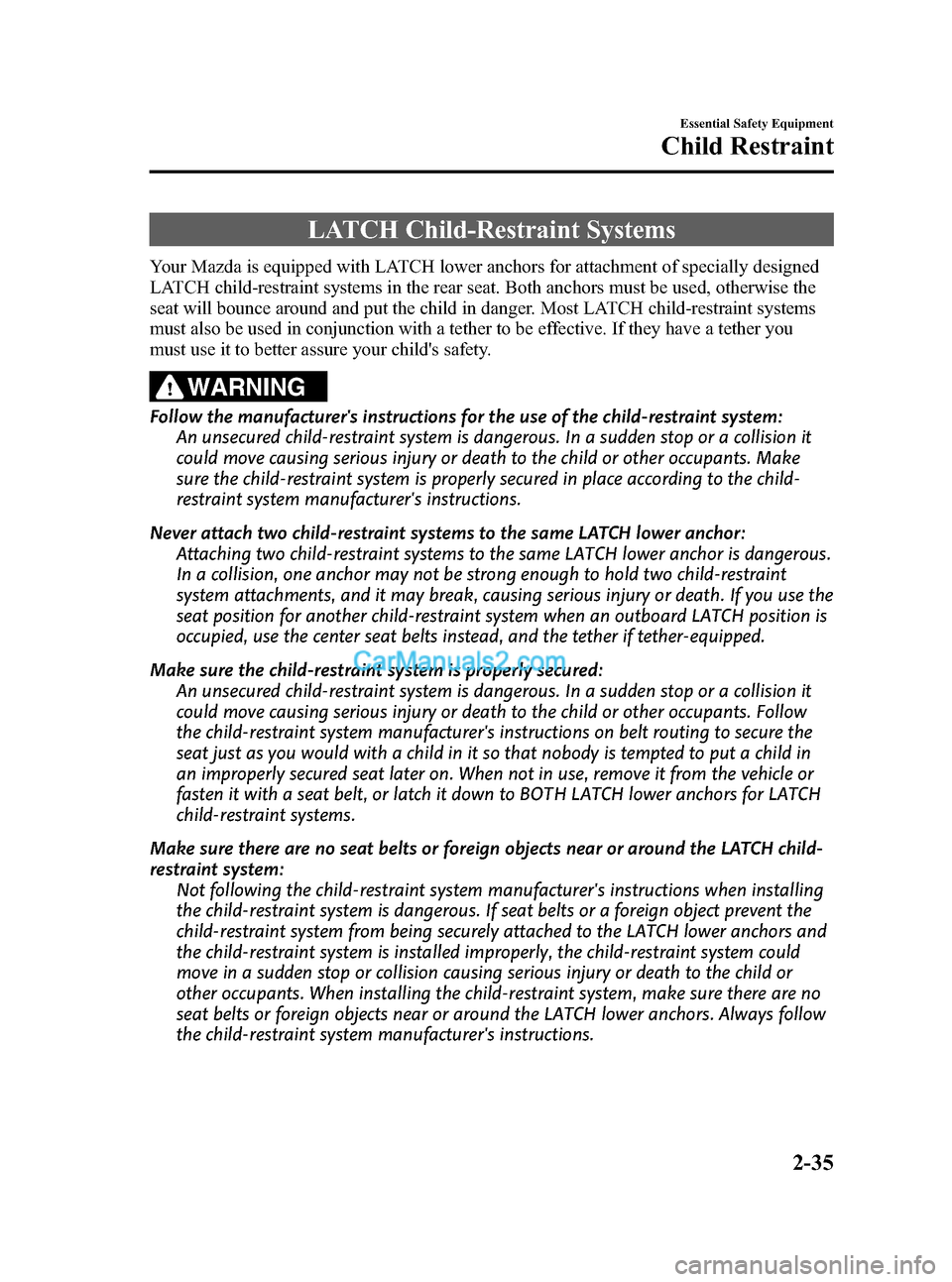
Black plate (49,1)
LATCH Child-Restraint Systems
Your Mazda is equipped with LATCH lower anchors for attachment of specially designed
LATCH child-restraint systems in the rear seat. Both anchors must be used, otherwise the
seat will bounce around and put the child in danger. Most LATCH child-restraint systems
must also be used in conjunction with a tether to be effective. If they have a tether you
must use it to better assure your child's safety.
WARNING
Follow the manufacturer's instructions for the use of the child-restraint system:
An unsecured child-restraint system is dangerous. In a sudden stop or a collision it
could move causing serious injury or death to the child or other occupants. Make
sure the child-restraint system is properly secured in place according to the child-
restraint system manufacturer's instructions.
Never attach two child-restraint systems to the same LATCH lower anchor:
Attaching two child-restraint systems to the same LATCH lower anchor is dangerous.
In a collision, one anchor may not be strong enough to hold two child-restraint
system attachments, and it may break, causing serious injury or death. If you use the
seat position for another child-restraint system when an outboard LATCH position is
occupied, use the center seat belts instead, and the tether if tether-equipped.
Make sure the child-restraint system is properly secured:
An unsecured child-restraint system is dangerous. In a sudden stop or a collision it
could move causing serious injury or death to the child or other occupants. Follow
the child-restraint system manufacturer's instructions on belt routing to secure the
seat just as you would with a child in it so that nobody is tempted to put a child in
an improperly secured seat later on. When not in use, remove it from the vehicle or
fasten it with a seat belt, or latch it down to BOTH LATCH lower anchors for LATCH
child-restraint systems.
Make sure there are no seat belts or foreign objects near or around the LATCH child-
restraint system:
Not following the child-restraint system manufacturer's instructions when installing
the child-restraint system is dangerous. If seat belts or a foreign object prevent the
child-restraint system from being securely attached to the LATCH lower anchors and
the child-restraint system is installed improperly, the child-restraint system could
move in a sudden stop or collision causing serious injury or death to the child or
other occupants. When installing the child-restraint system, make sure there are no
seat belts or foreign objects near or around the LATCH lower anchors. Always follow
the child-restraint system manufacturer's instructions.
Essential Safety Equipment
Child Restraint
2-35
Mazda3_8X41-EA-07F_Edition1 Page49
Wednesday, April 25 2007 1:4 PM
Form No.8X41-EA-07F
Page 51 of 394
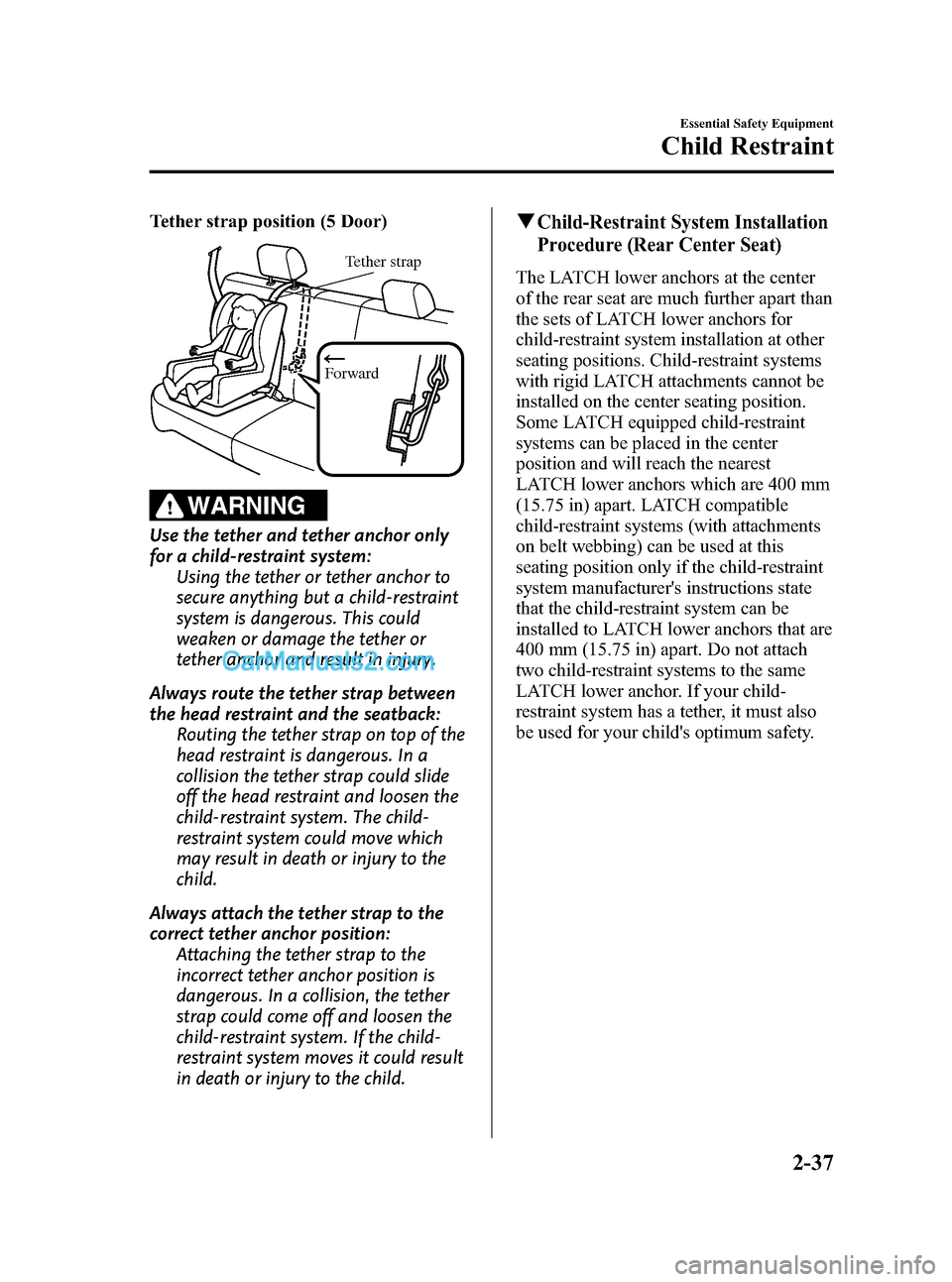
Black plate (51,1)
Tether strap position (5 Door)
Forward
Tether strap
WARNING
Use the tether and tether anchor only
for a child-restraint system:
Using the tether or tether anchor to
secure anything but a child-restraint
system is dangerous. This could
weaken or damage the tether or
tether anchor and result in injury.
Always route the tether strap between
the head restraint and the seatback:
Routing the tether strap on top of the
head restraint is dangerous. In a
collision the tether strap could slide
off the head restraint and loosen the
child-restraint system. The child-
restraint system could move which
may result in death or injury to the
child.
Always attach the tether strap to the
correct tether anchor position:
Attaching the tether strap to the
incorrect tether anchor position is
dangerous. In a collision, the tether
strap could come off and loosen the
child-restraint system. If the child-
restraint system moves it could result
in death or injury to the child.
qChild-Restraint System Installation
Procedure (Rear Center Seat)
The LATCH lower anchors at the center
of the rear seat are much further apart than
the sets of LATCH lower anchors for
child-restraint system installation at other
seating positions. Child-restraint systems
with rigid LATCH attachments cannot be
installed on the center seating position.
Some LATCH equipped child-restraint
systems can be placed in the center
position and will reach the nearest
LATCH lower anchors which are 400 mm
(15.75 in) apart. LATCH compatible
child-restraint systems (with attachments
on belt webbing) can be used at this
seating position only if the child-restraint
system manufacturer's instructions state
that the child-restraint system can be
installed to LATCH lower anchors that are
400 mm (15.75 in) apart. Do not attach
two child-restraint systems to the same
LATCH lower anchor. If your child-
restraint system has a tether, it must also
be used for your child's optimum safety.
Essential Safety Equipment
Child Restraint
2-37
Mazda3_8X41-EA-07F_Edition1 Page51
Wednesday, April 25 2007 1:4 PM
Form No.8X41-EA-07F
Page 52 of 394
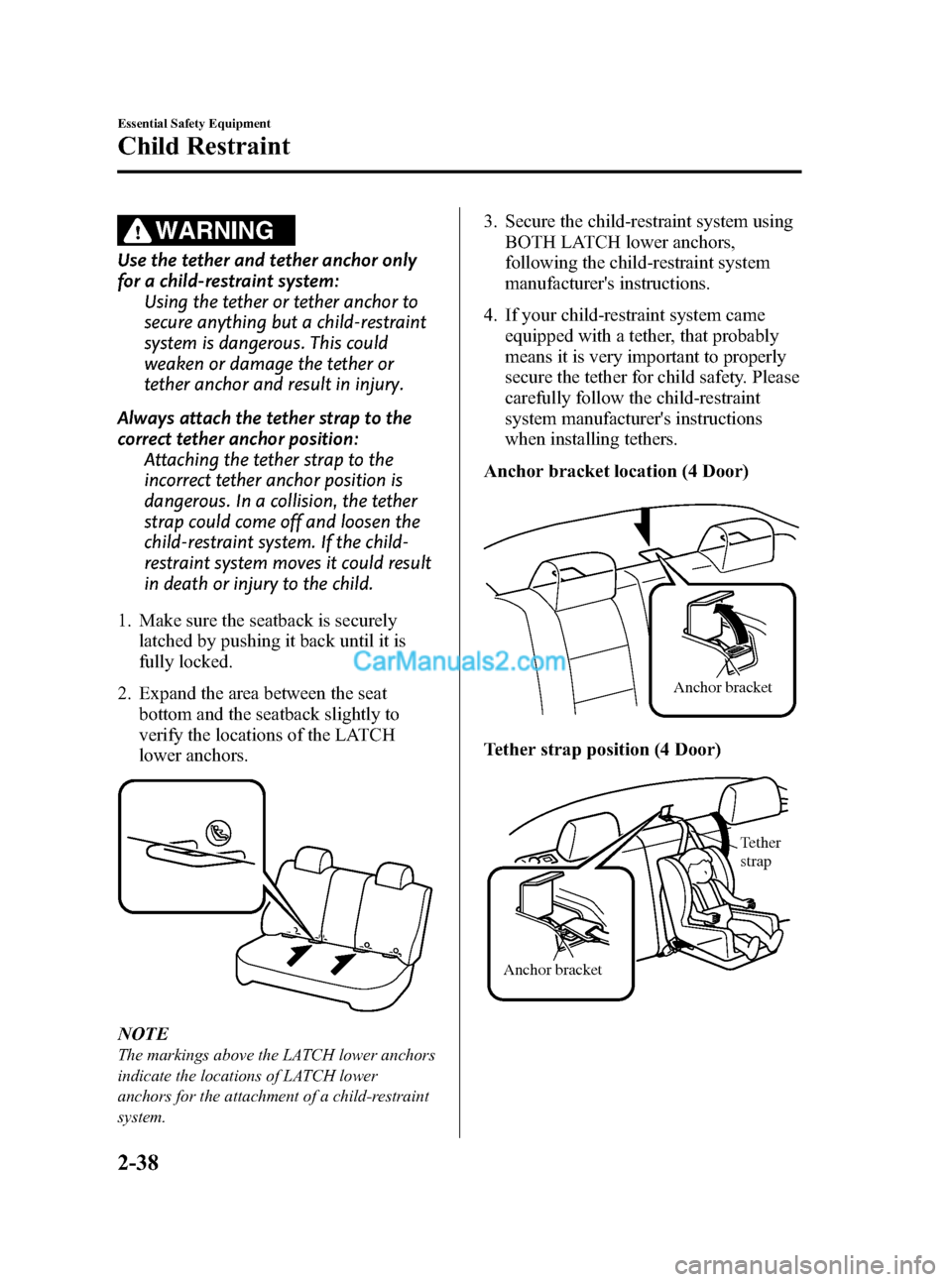
Black plate (52,1)
WARNING
Use the tether and tether anchor only
for a child-restraint system:
Using the tether or tether anchor to
secure anything but a child-restraint
system is dangerous. This could
weaken or damage the tether or
tether anchor and result in injury.
Always attach the tether strap to the
correct tether anchor position:
Attaching the tether strap to the
incorrect tether anchor position is
dangerous. In a collision, the tether
strap could come off and loosen the
child-restraint system. If the child-
restraint system moves it could result
in death or injury to the child.
1. Make sure the seatback is securely
latched by pushing it back until it is
fully locked.
2. Expand the area between the seat
bottom and the seatback slightly to
verify the locations of the LATCH
lower anchors.
NOTE
The markings above the LATCH lower anchors
indicate the locations of LATCH lower
anchors for the attachment of a child-restraint
system.
3. Secure the child-restraint system using
BOTH LATCH lower anchors,
following the child-restraint system
manufacturer's instructions.
4. If your child-restraint system came
equipped with a tether, that probably
means it is very important to properly
secure the tether for child safety. Please
carefully follow the child-restraint
system manufacturer's instructions
when installing tethers.
Anchor bracket location (4 Door)
Anchor bracket
Tether strap position (4 Door)
Anchor bracketTether
strap
2-38
Essential Safety Equipment
Child Restraint
Mazda3_8X41-EA-07F_Edition1 Page52
Wednesday, April 25 2007 1:4 PM
Form No.8X41-EA-07F
Page 55 of 394
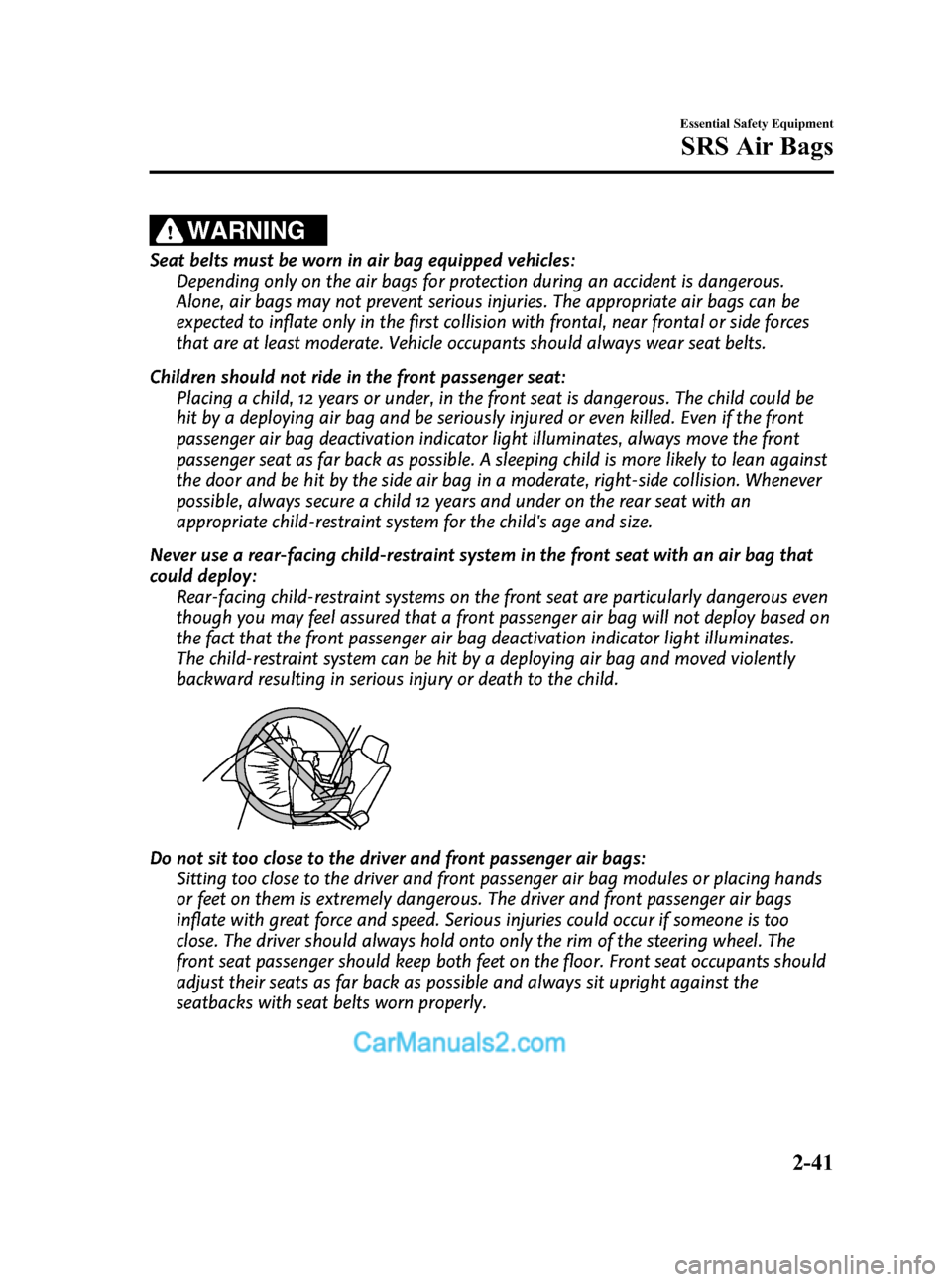
Black plate (55,1)
WARNING
Seat belts must be worn in air bag equipped vehicles:
Depending only on the air bags for protection during an accident is dangerous.
Alone, air bags may not prevent serious injuries. The appropriate air bags can be
expected to inflate only in the first collision with frontal, near frontal or side forces
that are at least moderate. Vehicle occupants should always wear seat belts.
Children should not ride in the front passenger seat:
Placing a child, 12 years or under, in the front seat is dangerous. The child could be
hit by a deploying air bag and be seriously injured or even killed. Even if the front
passenger air bag deactivation indicator light illuminates, always move the front
passenger seat as far back as possible. A sleeping child is more likely to lean against
the door and be hit by the side air bag in a moderate, right-side collision. Whenever
possible, always secure a child 12 years and under on the rear seat with an
appropriate child-restraint system for the child's age and size.
Never use a rear-facing child-restraint system in the front seat with an air bag that
could deploy:
Rear-facing child-restraint systems on the front seat are particularly dangerous even
though you may feel assured that a front passenger air bag will not deploy based on
the fact that the front passenger air bag deactivation indicator light illuminates.
The child-restraint system can be hit by a deploying air bag and moved violently
backward resulting in serious injury or death to the child.
Do not sit too close to the driver and front passenger air bags:
Sitting too close to the driver and front passenger air bag modules or placing hands
or feet on them is extremely dangerous. The driver and front passenger air bags
inflate with great force and speed. Serious injuries could occur if someone is too
close. The driver should always hold onto only the rim of the steering wheel. The
front seat passenger should keep both feet on the floor. Front seat occupants should
adjust their seats as far back as possible and always sit upright against the
seatbacks with seat belts worn properly.
Essential Safety Equipment
SRS Air Bags
2-41
Mazda3_8X41-EA-07F_Edition1 Page55
Wednesday, April 25 2007 1:4 PM
Form No.8X41-EA-07F
Page 61 of 394
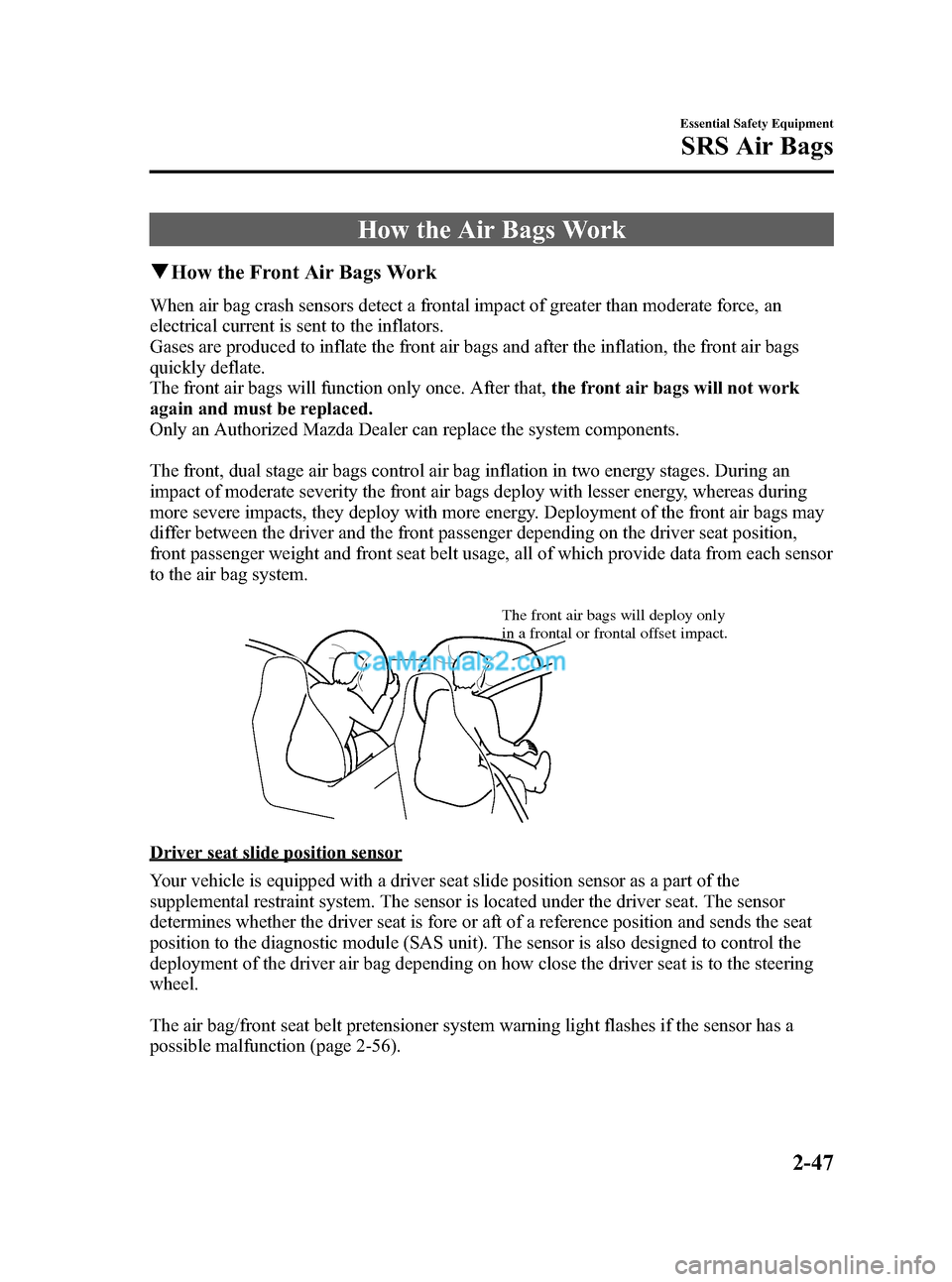
Black plate (61,1)
How the Air Bags Work
qHow the Front Air Bags Work
When air bag crash sensors detect a frontal impact of greater than moderate force, an
electrical current is sent to the inflators.
Gases are produced to inflate the front air bags and after the inflation, the front air bags
quickly deflate.
The front air bags will function only once. After that,the front air bags will not work
again and must be replaced.
Only an Authorized Mazda Dealer can replace the system components.
The front, dual stage air bags control air bag inflation in two energy stages. During an
impact of moderate severity the front air bags deploy with lesser energy, whereas during
more severe impacts, they deploy with more energy. Deployment of the front air bags may
differ between the driver and the front passenger depending on the driver seat position,
front passenger weight and front seat belt usage, all of which provide data from each sensor
to the air bag system.
The front air bags will deploy only
in a frontal or frontal offset impact.
Driver seat slide position sensor
Your vehicle is equipped with a driver seat slide position sensor as a part of the
supplemental restraint system. The sensor is located under the driver seat. The sensor
determines whether the driver seat is fore or aft of a reference position and sends the seat
position to the diagnostic module (SAS unit). The sensor is also designed to control the
deployment of the driver air bag depending on how close the driver seat is to the steering
wheel.
The air bag/front seat belt pretensioner system warning light flashes if the sensor has a
possible malfunction (page 2-56).
Essential Safety Equipment
SRS Air Bags
2-47
Mazda3_8X41-EA-07F_Edition1 Page61
Wednesday, April 25 2007 1:4 PM
Form No.8X41-EA-07F
Page 62 of 394
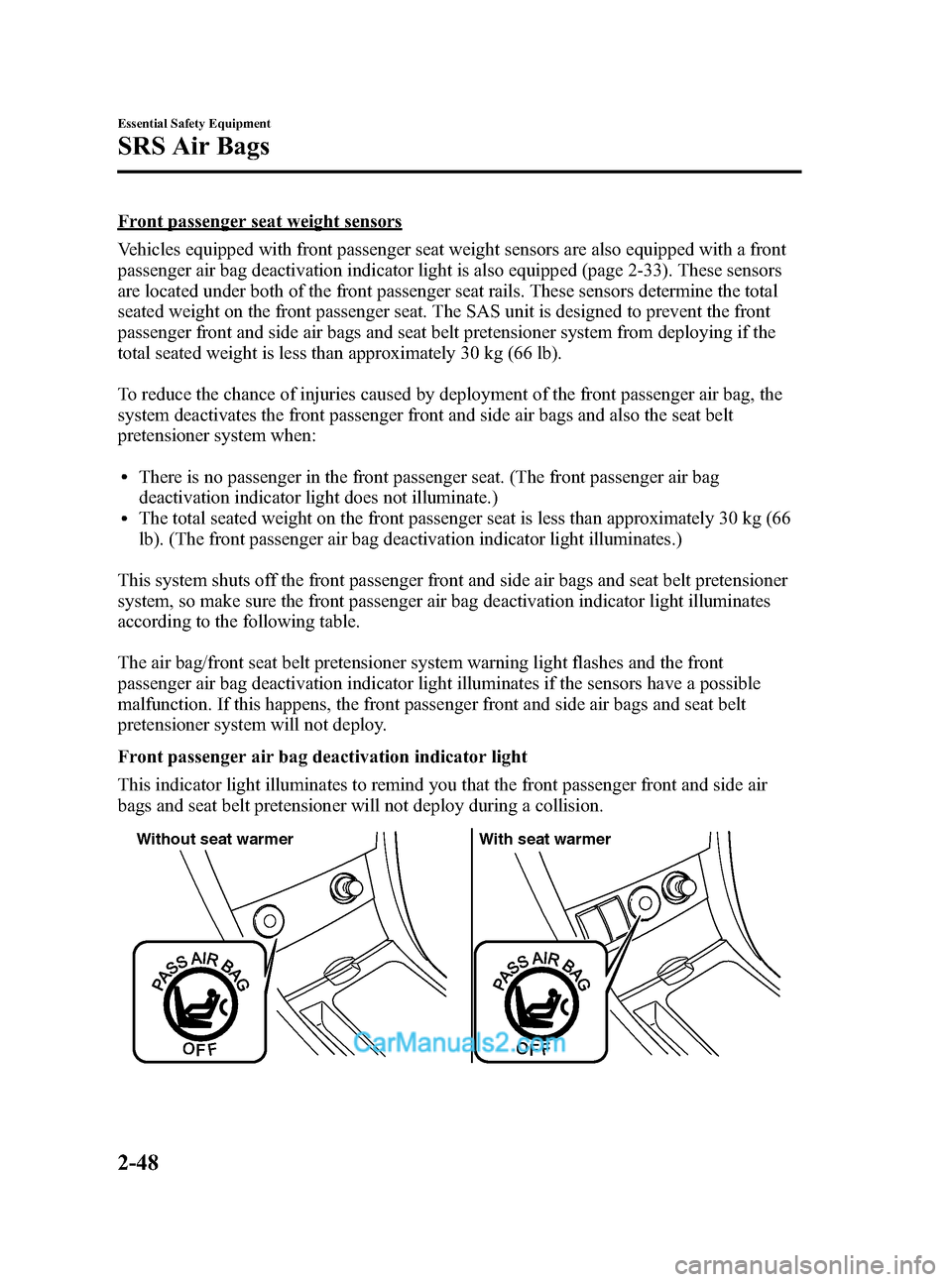
Black plate (62,1)
Front passenger seat weight sensors
Vehicles equipped with front passenger seat weight sensors are also equipped with a front
passenger air bag deactivation indicator light is also equipped (page 2-33). These sensors
are located under both of the front passenger seat rails. These sensors determine the total
seated weight on the front passenger seat. The SAS unit is designed to prevent the front
passenger front and side air bags and seat belt pretensioner system from deploying if the
total seated weight is less than approximately 30 kg (66 lb).
To reduce the chance of injuries caused by deployment of the front passenger air bag, the
system deactivates the front passenger front and side air bags and also the seat belt
pretensioner system when:
lThere is no passenger in the front passenger seat. (The front passenger air bag
deactivation indicator light does not illuminate.)
lThe total seated weight on the front passenger seat is less than approximately 30 kg (66
lb). (The front passenger air bag deactivation indicator light illuminates.)
This system shuts off the front passenger front and side air bags and seat belt pretensioner
system, so make sure the front passenger air bag deactivation indicator light illuminates
according to the following table.
The air bag/front seat belt pretensioner system warning light flashes and the front
passenger air bag deactivation indicator light illuminates if the sensors have a possible
malfunction. If this happens, the front passenger front and side air bags and seat belt
pretensioner system will not deploy.
Front passenger air bag deactivation indicator light
This indicator light illuminates to remind you that the front passenger front and side air
bags and seat belt pretensioner will not deploy during a collision.
With seat warmer Without seat warmer
2-48
Essential Safety Equipment
SRS Air Bags
Mazda3_8X41-EA-07F_Edition1 Page62
Wednesday, April 25 2007 1:4 PM
Form No.8X41-EA-07F
Page 64 of 394
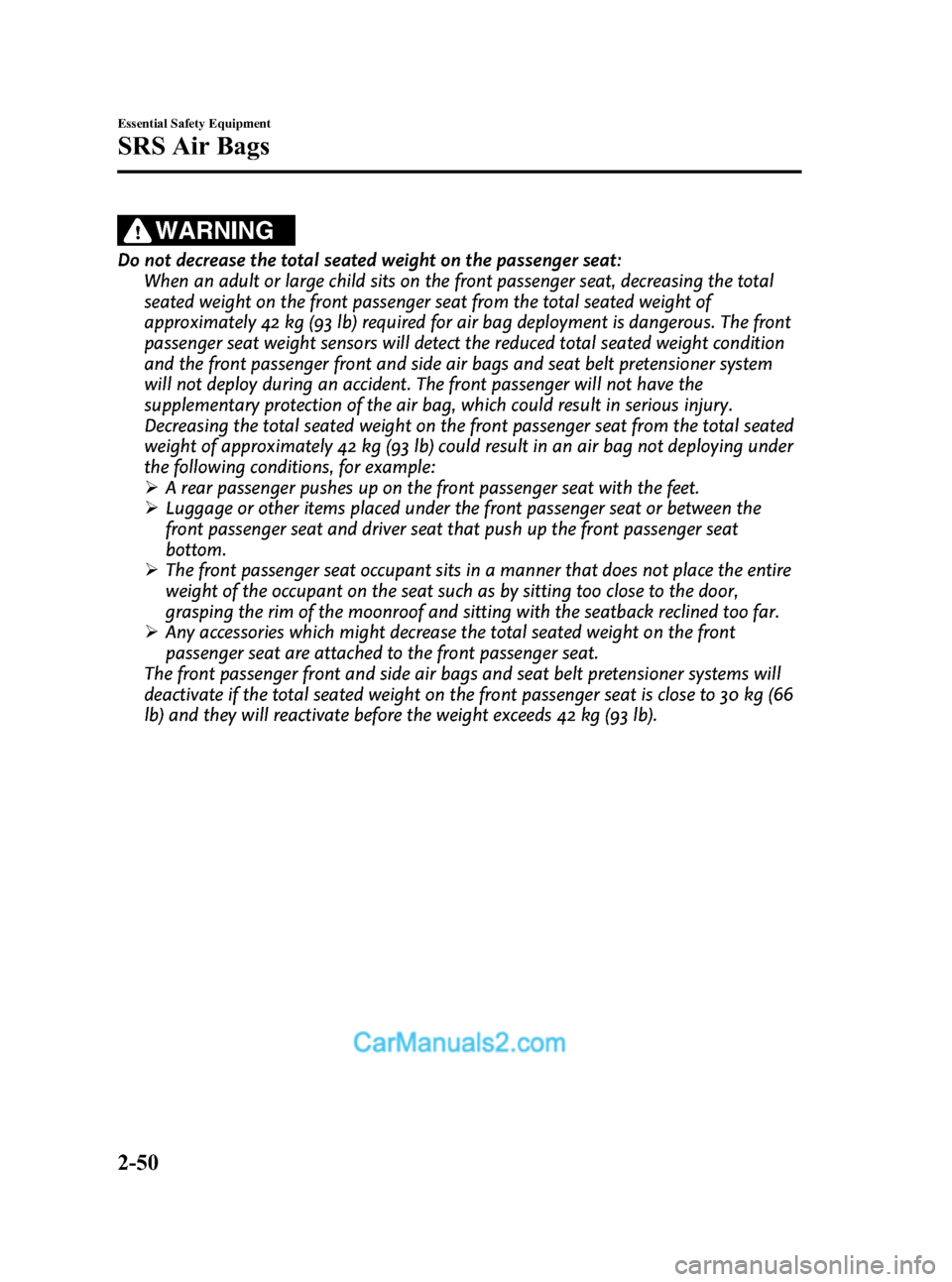
Black plate (64,1)
WARNING
Do not decrease the total seated weight on the passenger seat:
When an adult or large child sits on the front passenger seat, decreasing the total
seated weight on the front passenger seat from the total seated weight of
approximately 42 kg (93 lb) required for air bag deployment is dangerous. The front
passenger seat weight sensors will detect the reduced total seated weight condition
and the front passenger front and side air bags and seat belt pretensioner system
will not deploy during an accident. The front passenger will not have the
supplementary protection of the air bag, which could result in serious injury.
Decreasing the total seated weight on the front passenger seat from the total seated
weight of approximately 42 kg (93 lb) could result in an air bag not deploying under
the following conditions, for example:
ØA rear passenger pushes up on the front passenger seat with the feet.
ØLuggage or other items placed under the front passenger seat or between the
front passenger seat and driver seat that push up the front passenger seat
bottom.
ØThe front passenger seat occupant sits in a manner that does not place the entire
weight of the occupant on the seat such as by sitting too close to the door,
grasping the rim of the moonroof and sitting with the seatback reclined too far.
ØAny accessories which might decrease the total seated weight on the front
passenger seat are attached to the front passenger seat.
The front passenger front and side air bags and seat belt pretensioner systems will
deactivate if the total seated weight on the front passenger seat is close to 30 kg (66
lb) and they will reactivate before the weight exceeds 42 kg (93 lb).
2-50
Essential Safety Equipment
SRS Air Bags
Mazda3_8X41-EA-07F_Edition1 Page64
Wednesday, April 25 2007 1:4 PM
Form No.8X41-EA-07F
Page 69 of 394
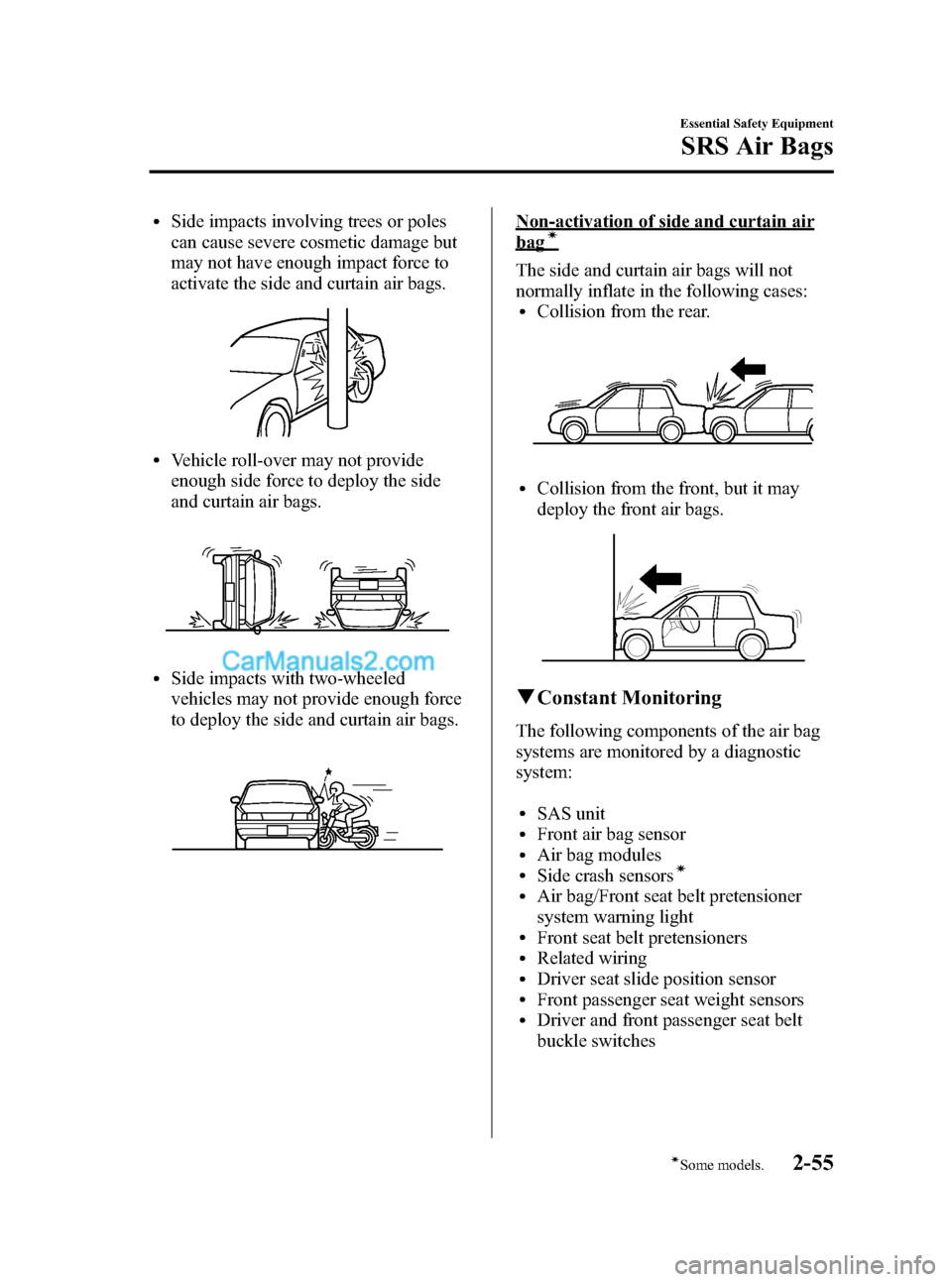
Black plate (69,1)
lSide impacts involving trees or poles
can cause severe cosmetic damage but
may not have enough impact force to
activate the side and curtain air bags.
lVehicle roll-over may not provide
enough side force to deploy the side
and curtain air bags.
lSide impacts with two-wheeled
vehicles may not provide enough force
to deploy the side and curtain air bags.
Non-activation of side and curtain air
bagí
The side and curtain air bags will not
normally inflate in the following cases:
lCollision from the rear.
lCollision from the front, but it may
deploy the front air bags.
qConstant Monitoring
The following components of the air bag
systems are monitored by a diagnostic
system:
lSAS unitlFront air bag sensorlAir bag moduleslSide crash sensorsí
lAir bag/Front seat belt pretensioner
system warning light
lFront seat belt pretensionerslRelated wiringlDriver seat slide position sensorlFront passenger seat weight sensorslDriver and front passenger seat belt
buckle switches
Essential Safety Equipment
SRS Air Bags
2-55íSome models. Mazda3_8X41-EA-07F_Edition1 Page69
Wednesday, April 25 2007 1:4 PM
Form No.8X41-EA-07F